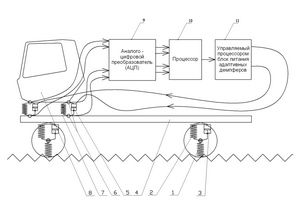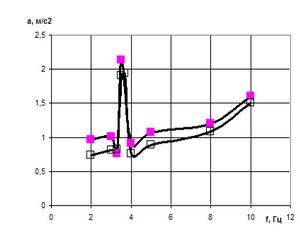Main Sector of relevance\IRC classification 8. Industrial Manufacturing, Material and Transport Technologies
8.17 Development of accessory cushioning system for special purpose heavy-weight truck (tractive vehicles) elements
Developers’ contact information
1) State Scientific Institution “The A.V.Lykov Institute of Heat and Mass Transfer of National Academy of Sciences of Belarus”
15 P.Brovka Street, Minsk BY-220072
Tel.: +375 (17) 284-21-38, fax: +375 (17) 292-25-13
Summary
The project is devoted to development, research and testing of
controlled accessory cushioning system for heavy-weight truck elements which is
based on rheological dispersities.
The cushioning system consists of a slave mechanism which is a viscous friction
shock damper with electro-driven (or magnet-driven) operating environment. Its
damping characteristics change exponentially on switching to external control
mode. The cushioning system also includes standard elastic elements and a
control unit complete with a vibration transmitter. The system is intended for
adaptive anti-vibration modes control initiated on transportation of
high-precision cargoes and can be used to provide appropriate operational
conditions both in motion and stationary functioning modes.
Specifications:
Description
The project is aimed at constructing a test model of an active anti-vibration system for heavy-weight vehicles elements based on the principle of anti-vibration device inertia and stiffness parameter control with viscous friction dampers used as actuator units. The system implements an efficient coupling method for hydraulic and electrical components implying elimination of kinematical connections which is achieved by electrostatic field direct impact on the damping unit operating liquid. The project resulted in the development of controlled parameters electrorheological compounds (damper operating liquids), procedures and hardware for automated vibration control systems of dynamically loaded elements, vehicle units and working stations (shock damper with electrorheological operating liquid (Fig. 1) and electronic control unit), which served as a basis for adaptive accessory cushioning system design (Figure 2).

Fig. 1 – Electrorheological shock damper appearance
a – bottom; b – top

Fig. 2 – Adaptive accessory cushioning system block diagram
Highly-qualified originating team has enough necessary research and practical
experience and is composed of employees working for the Heat and Mass Exchange
Institute named after A.V. Lykov of the National Academy of Sciences of Belarus
(major CIS institution specializing in this problem). Based on its long
experience in the sphere of non-linear viscoelastic liquids with the use of
available material and research resources, the Institute carried out studies to
determine electrorheological liquid physical properties, developed most
effective purpose-specific compounds, helped elaborate measurement methods and
media to define their structure control algorithms involving external fields
influences. The originating team also included employees of Associated
Institute of Manufacturing Engineering at the National Academy of Sciences of
Belarus who contributed to an adequate design of electronic system control
unit. The unitary Enterprise “Minsk Wheel Tractor Plant” (this is the end
user organization and its financial investments from its proper funds amounted
to 50% of the project cost) with the participation of the Heat and Mass
Exchange Institute named after A.V. Lykov at the National Academy of Sciences
of Belarus manufactured a shock damper, tested and examined anti-vibration
system elements on an available factory stand equipped with a standard
instrumentation set and validated the declared accessory cushioning system
parameters. Examples comparing amplitude-frequency features are illustrated on
Figure 3..

Fig. 3 – Damping system amplitude-frequency features with control on (1) and off (2) signals
The project resulted in development and proof trial of an active anti-vibration
system for heavy-weight vehicles construction elements which seems to be quite
competitive on the market.
Technology type
Technical advantages and economic benefits
Damping ratio for the vibration system with controlled operating liquid was increased up to 5 times.
Technology differentiation and uniqueness
Application of “smart” (electrorheological liquid) materials for the purpose of constructing a controlled vibration dampening system.
Context in which technology was identified
Unitary enterprise “Minsk Wheel Tractor Plant”, Republican Unitary Enterprise “Minsk tractor factory”.
Technological keywords
Heavy-weight vehicles, anti-vibration system, cushioning system, shock damper, electrorheology, electronic control system, electrical field, process procedure, design documentation, stand tests.
Development Stage
Intellectual property rights
Range of applications
Manufacturing engineering, transport.
Classifier Used at the EU Innovation Relay Centres
Preferable Regions
Practical experience
Tests at “Minsk Wheel Tractor Plant” (Belarus).
Environmental impact
None.
Type of collaboration sought
Terms and restrictions
Licensing.
Available technical assistance